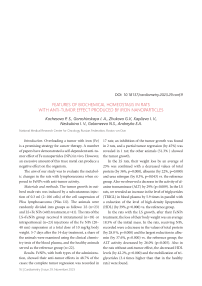Features of biochemical homeostasis in rats with anti-tumor effect produced by iron nanoparticles
Автор: Kachesova P.S., Goroshinskaya I. A., Zhukova G.V., Kaplieva I. V., Neskubina I. V., Golomeeva N.S., Andreyko E.A.
Журнал: Cardiometry @cardiometry
Рубрика: Conference proceedings
Статья в выпуске: 29, 2023 года.
Бесплатный доступ
Overloading a tumor with iron (Fe) is a promising strategy for cancer therapy. A number of papers have demonstrated a self-dependent anti-tumor effect of Fe nanoparticles (NPs) in vivo. However, an excessive amount of this trace metal can produce a negative effect on the organism. The aim of our study was to evaluate the metabolic changes in the rats with lymphosarcoma when exposed to FeNPs with anti-tumor activity.
Rats, lymphosarcoma, metallic iron nanoparticles, anti-tumor effect, biochemical homeostasis
Короткий адрес: https://sciup.org/148327381
IDR: 148327381 | DOI: 10.18137/cardiometry.2023.29.conf.9
Текст статьи Features of biochemical homeostasis in rats with anti-tumor effect produced by iron nanoparticles
National Medical Research Centre for Oncology Russian Federation, Rostov-on-Don
Introduction . Overloading a tumor with iron (Fe) is a promising strategy for cancer therapy. A number of papers have demonstrated a self-dependent anti-tumor effect of Fe nanoparticles (NPs) in vivo. However, an excessive amount of this trace metal can produce a negative effect on the organism.
The aim of our study was to evaluate the metabolic changes in the rats with lymphosarcoma when exposed to FeNPs with anti-tumor activity.
Materials and methods . The tumor growth in outbred male rats was induced by a subcutaneous injection of 0.3 ml (2~106 cells) of the cell suspension of Pliss lymphosarcoma (Pliss LS). The animals were randomly divided into groups as follows: LS (n=23) and LS+Fe NPs (with treatment, n=41). The rats of the LS+FeNPs group received 8 intratumoral (n=18) or intraperitoneal (n=23) injections of the Fe NPs (20– 40 nm) suspension at a total dose of 10 mg/kg body weight. 5-7 days after the 14-day treatment, a share of the animals were examined using the clinical chemistry tests of the blood plasma, and the healthy animals served as the reference group (n=22).
Results . FeNPs, with both types of the administration, showed their anti-tumor effects in 48.7% of the cases: the complete tumor regression was recorded in 16 | Cardiometry | Issue 29. November 2023
17 rats; an inhibition of the tumor growth was found in 2 rats, and a partial tumor regression (by 45%) was revealed in 1 rat; the other animals (51.3% ) showed the tumor growth.
In the LS rats, their weight loss by an average of 23% was combined with a decreased values of total protein (by 36%, p=0.000), albumin (by 22%, p=0.000) and urea nitrogen (by 8.3%, p=0.043) vs. the reference group. Also we observed a decrease in the activity of alanine transaminase (ALT) by 29% (p=0.009). In the LS rats, we revealed an increase in the level of triglycerides (TRIGL) in blood plasma by 5.9 times in parallel with a reduction of the level of high-density lipoproteins (HDL) (by 39%, p=0.000) vs. the reference group.
In the rats with the LS growth, after their FeNPs treatment, the loss of their body weight was an average 18.5% of the initial mass. In the rats, receiving NPs, recorded were a decrease in the values of total protein (by 28.0 %, p=0.000) and the largest reduction in albumin (by 37.6%, p=0.000) vs. the reference group; the ALT activity decreased by 26.0% (p=0.005). Also in the rats without anti-tumor effect, the decreased HDL levels (by 42.2%, p=0.000) and the mobilization of triglycerides (3.4 times higher than that in the healthy rats) were found.
In the rats with the tumor regression, after their exposure to FeNPs, compared with the rats with the tumor growth, signs of restoration of the balance of metabolism were observed. The animals showed an increase in their body weight by 8.3%, and the decrease in total protein in them was less pronounced than in the rats with the LS growth (by 8.7% vs. the reference group, p = 0.013). At the same time, in those rats, the albumin level remained low (by 29.0% compared to the healthy rats), and that was also the case with creatinine (by 29.3%, p=0.000) and urea nitrogen (by 38.6%, p= 0.000). In the LS+FeNPs group, the values of lipid metabolism parameters were not significantly different from those recorded in the reference group.
Conclusion . Thus, in the LS rats without the above treatment, signs of metabolic disorders characteristic of the tumor progression were observed. The direction and severity of the changes in metabolism in response to the action of FeNPs depended on the presence of an anti-tumor effect. The effect produced by NPs on the rats with the growing tumors did not significantly affect their metabolic status, since it did not differ from the rats without NPs treatment. The reorganization of metabolism in the rats with the tumor regression after exposure to NPs was associated with a change not in lipid, but in protein metabolism.


